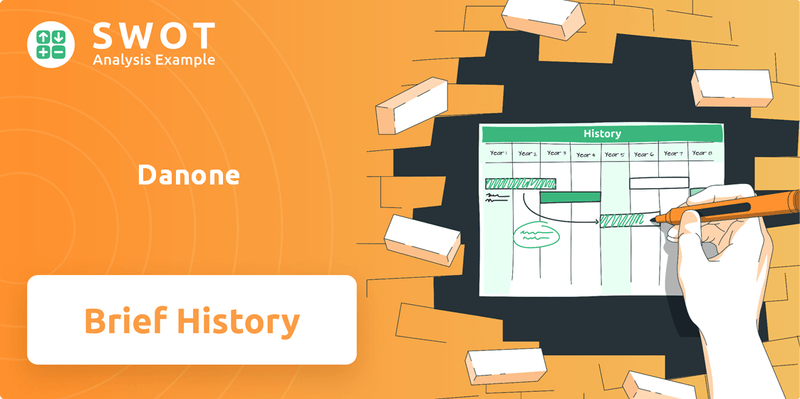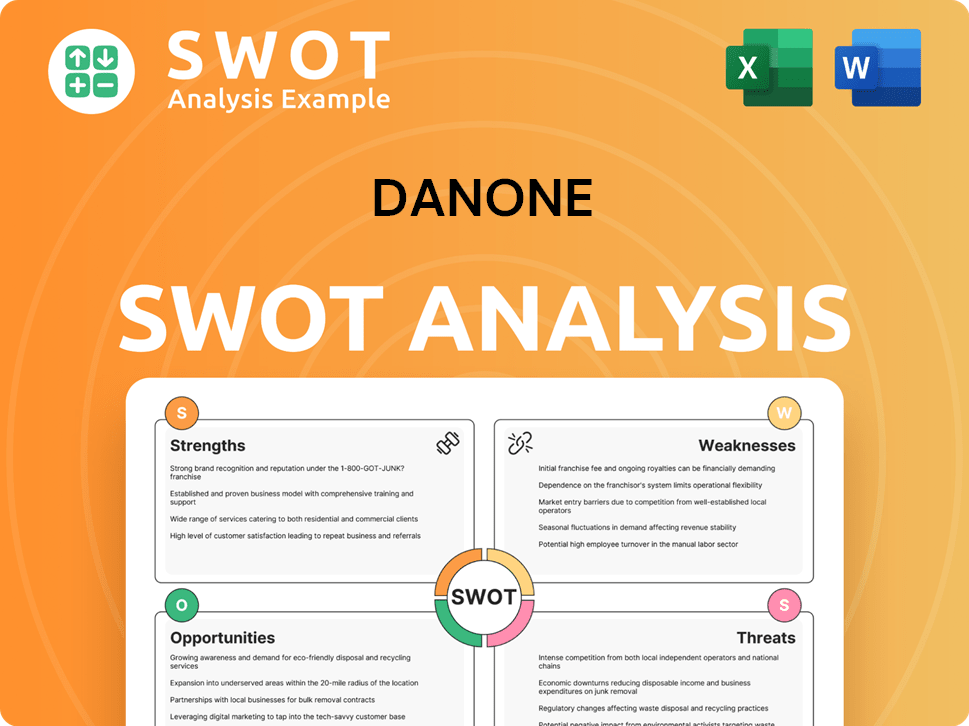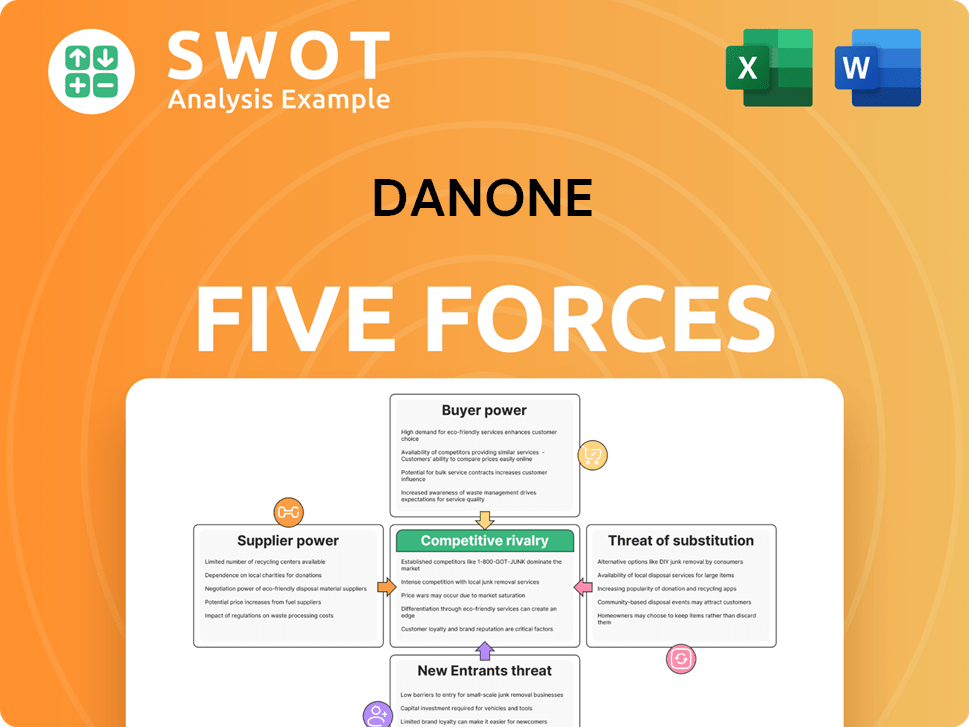Danone Bundle
How did a simple yogurt revolutionize the food industry?
Journey back in time to uncover the fascinating Danone SWOT Analysis of a global giant. From its humble Danone origins in Barcelona, Spain, to its current status as a multinational powerhouse, Danone's story is one of innovation and strategic expansion. Discover the Danone company's remarkable transformation and its impact on the world's food landscape.

This deep dive into the Danone history will explore the Danone timeline, detailing the company's Danone brands and Danone products that have shaped its success. We'll examine the early days of Danone, explore its Danone company founder and trace its Danone acquisition history, providing a comprehensive understanding of how Danone became a leader in the food and beverage industry, and its Danone's expansion globally.
What is the Danone Founding Story?
The Danone history began on September 2, 1919, in Barcelona, Spain. Isaac Carasso, a physician of Sephardic Jewish heritage, established the company with a vision to improve public health.
Carasso observed widespread digestive issues and malnutrition, particularly among children. He saw an opportunity to produce and market yogurt, a fermented dairy product known for its health benefits. This marked the Danone origins.
Carasso's initial business model involved producing yogurt on a small scale. He sold it through pharmacies as a medicinal product to help children with intestinal infections. He applied scientific knowledge from the Pasteur Institute to refine his yogurt production. The brand name 'Danone' was derived from his son Daniel's nickname, 'Danon'.
The yogurt was packaged in small porcelain jars and gained a reputation for its quality and health benefits, leading to rapid sales growth.
- The company pioneered the commercial packaging and sale of yogurt.
- Initial funding was likely through a bootstrapping approach, given the early sales success.
- The Danone company quickly expanded its reach.
- The brand's early success set the stage for its future growth.
Danone SWOT Analysis
- Complete SWOT Breakdown
- Fully Customizable
- Editable in Excel & Word
- Professional Formatting
- Investor-Ready Format

What Drove the Early Growth of Danone?
The early growth of the Danone company saw its expansion beyond Spain, marking a significant shift in its operational scope. This period was characterized by strategic moves into new markets and the diversification of its product offerings. These expansions were crucial in establishing the company as a global player in the food industry. This phase is a key part of the Danone history.
In 1929, Isaac Carasso moved the company to France. His son, Daniel Carasso, launched Société Parisienne du Yoghourt Danone in Paris. The first store opened in Montmartre. This expansion focused on the health benefits of yogurt while also emphasizing taste to make healthy products more enjoyable, setting the stage for future Danone brands.
Further international expansion occurred in 1942. Daniel Carasso moved to New York and founded Dannon Milk Products, Inc., the first American yogurt company. The brand name was changed to 'Dannon' for easier pronunciation. Initially, the US market presented challenges. However, Dannon achieved remarkable growth with nationwide delivery and a variety of flavored yogurts, becoming a market leader. Learn more about Revenue Streams & Business Model of Danone.
A significant development in Europe was the 1967 merger with Gervais, France's leading fresh cheese producer. This resulted in the company being renamed Gervais Danone. This merger broadened Danone's customer base. In 1973, Gervais Danone merged with Boussois-Souchon-Neuvesel (BSN), a glass manufacturer that had diversified into the food industry with acquisitions like Evian and Blédina. This marked a strategic shift towards international expansion and product diversification.
These early expansions and acquisitions laid the foundation for Danone's global presence. The company's focus on health, taste, and strategic partnerships has been key. This early growth phase showcases the Danone company's commitment to innovation and market adaptation, shaping its trajectory in the food industry. The Danone timeline is marked by these significant milestones.
Danone PESTLE Analysis
- Covers All 6 PESTLE Categories
- No Research Needed – Save Hours of Work
- Built by Experts, Trusted by Consultants
- Instant Download, Ready to Use
- 100% Editable, Fully Customizable

What are the key Milestones in Danone history?
The Danone history is marked by significant milestones, reflecting its evolution from a local yogurt producer to a global leader in the food and beverage industry. Key moments have shaped the
| Year | Milestone |
|---|---|
| 1919 | Isaac Carasso starts a yogurt business in Barcelona, Spain, using yogurt to help children with intestinal issues. |
| 1929 | The company expands to France, establishing its presence in the European market. |
| 1983 | The first Daniel Carasso International Research Center is inaugurated, focusing on fresh dairy products. |
| 2007 | The acquisition of Numico significantly accelerates Danone's journey into the baby foods market. |
| 2013 | Danone opens Nutricia Research, an innovation center in the Netherlands, dedicated to specialized nutrition research and development. |
| 2023 | Danone opens a new Global Research Center in Paris-Saclay, France, to act as an innovation catalyst. |
Innovation has been a cornerstone of
Danone pioneered the commercial packaging of yogurt, making it accessible to a wider audience. This innovation transformed the dairy industry and set a new standard for product distribution.
The introduction of fruit-flavored yogurts expanded the appeal of yogurt, attracting new consumers. This innovation diversified the product range and increased market share.
The acquisition of Numico in 2007 significantly boosted Danone's presence in the baby food market. This strategic move expanded the company's portfolio into specialized nutrition.
Danone has embraced plant-based food and beverages, responding to consumer demand for healthier options. This diversification reflects a commitment to sustainability and changing dietary preferences.
The company has invested in specialized nutrition for infants and adults. This includes research and development in areas like baby formula and medical nutrition products.
Opening research centers like Nutricia Research and the Global Research Center in Paris-Saclay underscores Danone's commitment to innovation. These centers focus on developing new products and improving existing ones.
The
Danone has experienced market downturns, requiring strategic adjustments to maintain profitability. These challenges often involve adapting to changing consumer behaviors and economic conditions.
The company faces competition from other major food and beverage companies. Staying competitive requires continuous innovation and effective marketing strategies.
Leadership changes, such as the appointment of Antoine Bernard de Saint-Affrique as CEO in 2021, can bring new strategic directions. These transitions often involve balancing sustainability and shareholder value.
Danone has committed to 100% recyclable, reusable, or compostable packaging by 2025. The company is also working towards deforestation-free supply chains by the same year.
Danone has addressed controversies, such as the rumored PepsiCo acquisition case in 2005-2006. These events require careful management and strategic responses.
In the US, Dannon initially struggled to establish itself based solely on its health niche. This required adapting marketing strategies to resonate with a broader consumer base.
Danone Business Model Canvas
- Complete 9-Block Business Model Canvas
- Effortlessly Communicate Your Business Strategy
- Investor-Ready BMC Format
- 100% Editable and Customizable
- Clear and Structured Layout

What is the Timeline of Key Events for Danone?
The Danone history is a story of innovation and expansion, beginning with its
origins
in Barcelona and evolving into a global food and beverage leader. From itsDanone company
founder, Isaac Carasso, selling yogurt in pharmacies, to its current status, the company has consistently adapted to changing consumer needs and market dynamics, marking significant milestones along the way.| Year | Key Event |
|---|---|
| 1919 | Isaac Carasso founds Danone in Barcelona, Spain, initially selling yogurt in pharmacies. |
| 1929 | Daniel Carasso expands Danone to France, opening a plant in Paris. |
| 1942 | Daniel Carasso establishes Dannon Milk Products, Inc. in New York, introducing yogurt to the US. |
| 1967 | Danone merges with Gervais, becoming Gervais Danone and forming France's first food group. |
| 1973 | Gervais Danone merges with BSN (Boussois-Souchon-Neuvesel), diversifying into beverages and infant nutrition. |
| 1983 | The first Daniel Carasso International Research Center is inaugurated near Paris. |
| 2007 | Danone acquires Numico, significantly expanding its specialized nutrition business. |
| 2013 | Danone opens Nutricia Research in the Netherlands, an innovation center for specialized nutrition. |
| 2017 | Danone launches its 'One Planet. One Health' vision, emphasizing the interconnectedness of human and planetary health. |
| 2018 | Danone North America achieves B Corp Certification. |
| 2021 | Antoine Bernard de Saint-Affrique is appointed CEO. |
| 2023 | Danone unveils its 'Danone Impact Journey' sustainability roadmap. |
| 2024 | Danone reports €27.38 billion in sales, a 4.3% like-for-like increase. |
| 2025 | Danone aims to become fully B Corp certified globally. |
Looking ahead to the 2025-2028 period, Danone plans to grow its net sales between 3% and 5% annually. This growth will be driven by focusing on high-protein, coffee creation, and medical nutrition categories. The company also plans to be more acquisitive while maintaining financial discipline.
Danone is committed to sustainability, aiming for 100% recyclable, reusable, or compostable packaging by 2025. They are also working towards deforestation-free supply chains by the end of 2025. In 2025, Danone sequestered approximately 51,200 tons of CO2 equivalent through regenerative agriculture practices.
Danone Porter's Five Forces Analysis
- Covers All 5 Competitive Forces in Detail
- Structured for Consultants, Students, and Founders
- 100% Editable in Microsoft Word & Excel
- Instant Digital Download – Use Immediately
- Compatible with Mac & PC – Fully Unlocked

Related Blogs
- What is Competitive Landscape of Danone Company?
- What is Growth Strategy and Future Prospects of Danone Company?
- How Does Danone Company Work?
- What is Sales and Marketing Strategy of Danone Company?
- What is Brief History of Danone Company?
- Who Owns Danone Company?
- What is Customer Demographics and Target Market of Danone Company?
Disclaimer
All information, articles, and product details provided on this website are for general informational and educational purposes only. We do not claim any ownership over, nor do we intend to infringe upon, any trademarks, copyrights, logos, brand names, or other intellectual property mentioned or depicted on this site. Such intellectual property remains the property of its respective owners, and any references here are made solely for identification or informational purposes, without implying any affiliation, endorsement, or partnership.
We make no representations or warranties, express or implied, regarding the accuracy, completeness, or suitability of any content or products presented. Nothing on this website should be construed as legal, tax, investment, financial, medical, or other professional advice. In addition, no part of this site—including articles or product references—constitutes a solicitation, recommendation, endorsement, advertisement, or offer to buy or sell any securities, franchises, or other financial instruments, particularly in jurisdictions where such activity would be unlawful.
All content is of a general nature and may not address the specific circumstances of any individual or entity. It is not a substitute for professional advice or services. Any actions you take based on the information provided here are strictly at your own risk. You accept full responsibility for any decisions or outcomes arising from your use of this website and agree to release us from any liability in connection with your use of, or reliance upon, the content or products found herein.